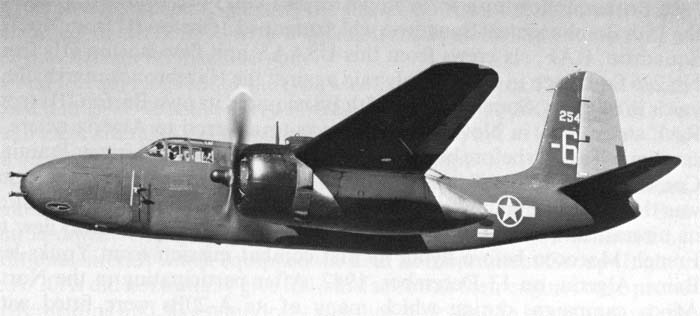History
Background
The P-70 was developed as an interim solution to meet the US Army Air Forces’ urgent need for a night fighter, based on the readily adaptable A-20 Havoc airframe.
As the United States edged closer to entering the war, the Air Corps recognized the need for a radar-equipped night fighter to counter potential bomber threats. With the more advanced Northrop P-61 Black Widow still years away, the Army ordered Douglas to convert 60 A-20s into night fighters. The first of these conversions, designated XP-70, served as a proof of concept. Its success led to a formal decision in October 1940 to proceed with 59 additional conversions under the designation P-70.
These early P-70s were powered by Wright R-2600-11 engines, the same found on the A-20A, without supercharging. Although the turbo-supercharged R-2600-7 engines had been considered, they had already proven unreliable on earlier Havoc variants. This decision, combined with a general underestimation of high-altitude performance requirements, ultimately limited the P-70’s effectiveness in combat.
The radar system installed was the SCR-540, a US-built version of the British AI Mk. IV. Housed in an unglazed solid nose with a prominent arrowhead-shaped transmitter antenna, it operated on a 1.5-meter wavelength. While advanced for its time, the system suffered from significant ground clutter interference at low altitudes. Dipole receiving antennas were installed on either side of the nose, with additional antennas mounted on the left wing.
Internally, the aircraft saw significant reconfiguration. The bombardier’s position and nose-mounted weapons were removed, while the rear gunner’s station was repurposed for the radar operator. The defensive armament was eliminated, reducing the crew from three to two. A 250-gallon auxiliary fuel tank was installed in the bomb bay, alongside a tray-mounted battery of four 20 mm cannons, each supplied with 120 rounds.
The 59 production P-70s were delivered between April and September 1942 and were officially nicknamed Nighthawk. Around thirty of these were delivered to Orlando, Florida, in July 1942, where they were assigned to the 481st Night Fighter Operational Training Group. There, they played a vital role in training new night fighter crews and developing radar interception tactics. In total, P-70s supported the formation and training of 19 night fighter squadrons.
Operationally, the P-70 saw limited service in the Pacific Theater. The 6th and 419th Night Fighter Squadrons deployed them to Guadalcanal in February 1943 to counter increasing Japanese night raids, while the 418th and 421st Night Fighter Squadrons flew them briefly over New Guinea. The P-70 was proven to be a struggling platform for the night fighter in combat, as it was too slow, had poor climb performance, and was generally ineffective in intercepting enemy aircraft at altitude.
Ultimately, the P-70 achieved only two confirmed aerial kills during the war. Nevertheless, its contribution as a training and transitional platform was essential. It helped build the foundation for America’s night fighting force and prepared crews for the much more capable P-61 Black Widow.
Enter the P-70A-2 Variant - Converting the A-20G into a Night Fighter
The P-70A-2 was a follow-on variant to the earlier XP-70, P-70, and P-70A-1 models. Unlike its predecessors, it was based on an early production A-20G airframe that lacked a rear power turret. This variant retained the full forward armament of six fixed .50 caliber machine guns in the nose, unlike earlier models, where the radar was mounted in the nose. Instead, the radar equipment was relocated to the bomb bay and the gunner’s compartment.
The SCR-540 radar remained the same, with the prominent transmitting antenna mounted between the nose guns. Receiving dipole antennas were still installed on either side of the nose and the upper left wing. As with previous P-70 conversions, all defensive armament was removed to reduce weight and accommodate the radar operator.
The P-70A-2 was powered by the slightly uprated Wright R-2600-23 radial engines, replacing the -11 series used on the original P-70. However, these engines remained unsupercharged, continuing to limit high-altitude performance.
Most P-70A-2s were assigned to training duties, particularly at the night fighter training facility in Orlando, Florida. A small number were deployed to the Pacific Theater, notably with the 6th Night Fighter Squadron on Guadalcanal, where they were used to intercept Japanese night raids.
In total, 65 A-20G airframes were converted into the P-70A-2 night fighter configuration.







